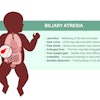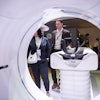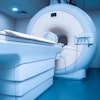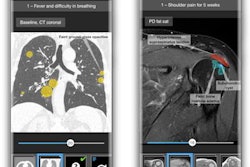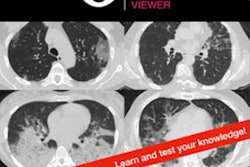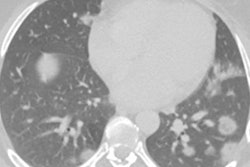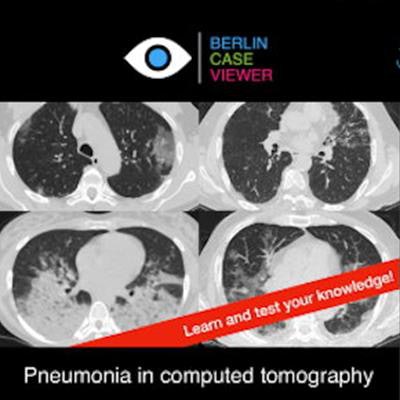
A free app designed to train medical imaging professionals in COVID-19 case recognition is making progress. While other apps exist, users of the BerlinCaseViewer app have access to all the CT slices they would have on their workstations in normal clinical practice, the developers say.
Over 600 individuals in countries across North and South America, Europe, and Australia have downloaded the app, which exists in its full version with 19 fully anonymized cases using 470 MB of file space. The COVID-19 learning module also exists in a "lighter" 80 MB version of eight cases, suitable for radiologists in countries with limited internet access or slower bandwidth, with downloads to date made by India-based doctors.
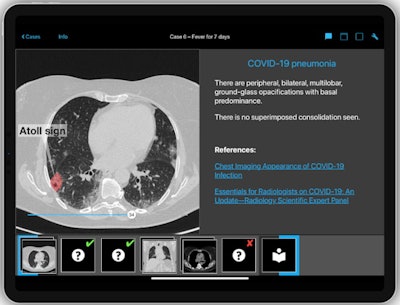 Colored overlays show the radiological signs typical of the relevant pathology in the correction. All images courtesy of Dr. Kay-Geert Hermann.
Colored overlays show the radiological signs typical of the relevant pathology in the correction. All images courtesy of Dr. Kay-Geert Hermann.To access the training tool, which takes the form of an interactive case-based quiz, radiologists can download the program for free at berlincaseviewer.de or directly in the Apple App Store. They are then presented with the first of 19 cases, the patient's clinical history and the chance to scroll through the entire CT dataset for that patient, with typically over 50 slices per case.
Special features
"A part of the skills to be learnt comprises of picking the slice that best shows the pathology in question, or the relevant radiological signs. The capacity to scroll through all the imaging data of a patient is unique to our tool," noted app founder Dr. Kay-Geert Hermann, consultant radiologist at Charité University Hospital in Berlin. "Another unique feature are the colored overlays showing the radiological signs typical of the relevant pathology once the participant has made a diagnosis."
Participants can move the scroller bar at their own speed through each slice of the chest CT set. They are then asked three questions pertaining to radiological signs visualized, distribution, and a final question about pathology diagnosis. Participants can also access more images in different views after each question, and they can split the screen in two to compare views side by side. Once the participant makes his or her choice about the pathology depicted, the correct answer is provided, along with an annotated image with colored overlays showing the sign that may have been overlooked. Links to scientific papers relevant to the particular case are also provided with the correct answer.
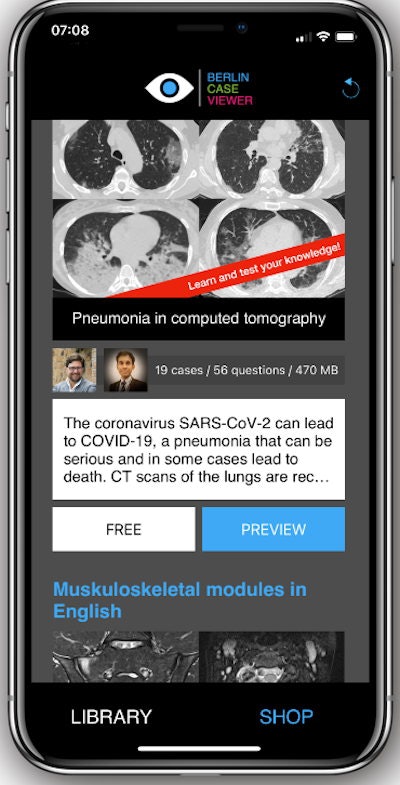 Participants can scroll through the full CT dataset per case and access the clinical history available before deciding on diagnosis.
Participants can scroll through the full CT dataset per case and access the clinical history available before deciding on diagnosis.The 19 cases cover a range of pneumonia types and pathologies that can mimic COVID-19 or that are in differential diagnosis with it, with half COVID-19, and half non-COVID-19 datasets. In the light version, two-thirds of cases come from pandemic patients.
Product development
The app stemmed from an existing interactive iPad-based training solution for rheumatology workshops developed in 2014 by Hermann and his team at BerlinFlame GmbH, with a relaunch after modification in 2019 to the wider public via the AppStore in both a paid-for and free versions.
So how did this software transition to COVID-19 training?
Initial education during the COVID-19 pandemic was based on the emerging literature and static case quizzes in journals. Italy was the first major hotspot after China. With access to vast COVID-19 patient numbers Dr. Fabio Macori, consultant radiologist at the Santo Spirito hospital in Rome, provided cases for a quiz in Radiopaedia.org, an open-edit educational radiology resource, founded by Australian radiologists.
"There were lots of COVID-19 patients at my hospital. I could provide plenty of anonymous cases, but I thought that the quiz should be interactive," he noted.
Meanwhile Hermann contacted a section editor for Radiopaedia.org, consultant radiologist Dr. Yuranga Weerakkody from the Royal Perth Hospital in Australia, with a view to collaboration, and the three of them set to work in March on extending the existing rheumatology solution with the training app for COVID-19 detection. With Hermann and his IT specialists working on the software, Macori provided the cases, and Weerakkody made the literature search, set the questions for participants, and annotated the images.
Interestingly, the three had never met in person. An intense period of development over eight weeks between the three doctors resulted in the app being ready to launch in mid-May.
Sharing weapons
"Ethically we didn't feel we wanted money for the app, just for it to be as widely distributed as possible. Every article on [COVID-19] is open access – so we three agreed to release it for free as we are all fighting the same battle," noted Macori.
Over the next four weeks, the creators are planning to add a chapter about different manifestations and radiological appearances of COVID-19, to be read by participants before they access the CT cases. The team is also preparing translations of the cases in Spanish, Portuguese, French, Italian, and German as the current software only has cases in English.
Downloads have remained stable over summer and into Autumn but with much of Europe now in a second wave, demand for the app could increase, noted Macori, who pointed to growing numbers of symptomatic and asymptomatic patients at his Rome hospital.
In Berlin, preparations are already underway for increasing COVID-19 cases, with general clinical work reduced to 75% and the knock-on effect of fewer patients freeing up the intensive care units. Moreover, an additional COVID-19-dedicated ICU opened in mid-October.
"Nobody believes that the next couple of weeks will be quiet. There is definitely a second spike coming," Hermann noted.
